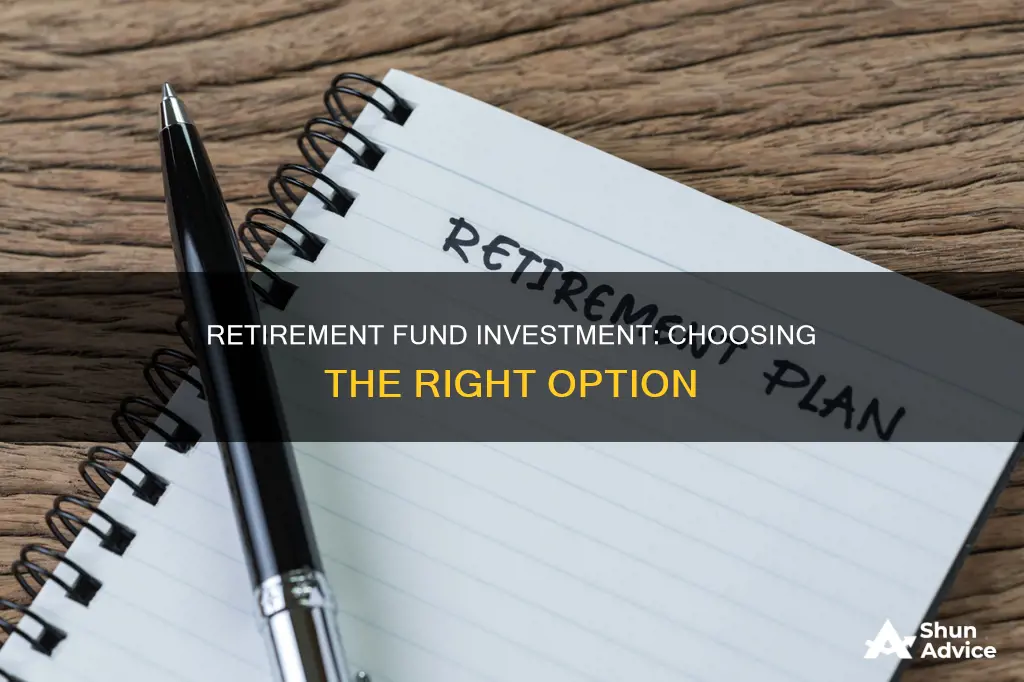
Retirement planning can be a daunting task, but it is essential to ensure financial security during your golden years. The first step is to determine your risk tolerance and financial circumstances, which will influence the types of investments suitable for your retirement portfolio. The primary goal is to balance income generation with capital preservation and growth. Here are some options to consider:
- Income Annuities: Annuities provide a guaranteed income stream, either for a fixed period or life. They offer tax-deferred growth, flexibility, and the potential for continued payments to beneficiaries. However, they may have limited liquidity, and withdrawals before a certain age can incur penalties.
- Diversified Bond Portfolio: With the recent increase in interest rates, bonds have become more attractive for retirement income. They offer a stream of income with competitive yields and provide effective diversification to offset risks associated with equities and other asset classes.
- Total Return Investment Approach: This strategy focuses on generating income through interest, dividends, and capital gains. It involves investing in a diverse mix of stock and bond funds, adjusted for your risk tolerance, and taking systematic withdrawals. While this approach may offer superior returns, there is no guarantee that funds will last throughout retirement.
- Income-producing Equities: Some stocks pay competitive dividends, providing a regular stream of income. Dividend-paying stocks can be attractive when interest rates are low, but they may become less appealing as rates rise.
- Mutual Funds and ETFs: These professionally managed investment vehicles provide diversified exposure to various assets, such as stocks, bonds, precious metals, and commodities. They are suitable for long-term retirement portfolios due to their high diversification and low fees.
- Target-Date Funds: These funds automatically adjust their asset allocation based on your target retirement date, becoming more conservative as you approach retirement.
Retirement Fund Characteristics Table
| Characteristics | Values |
|---|---|
| Type | Defined contribution plans, Traditional pensions, Guaranteed income annuities, Cash-value life insurance plan, Nonqualified deferred compensation plans, Individual retirement accounts, Target-date funds, Total return investment approach, Income-producing equities |
| Investment Options | Stocks, Bonds, Mutual funds, Exchange-traded funds, Dividend-paying stocks, Annuities, Cash, CDs, TIPS Bond ETF, REITs |
| Risk | High, Medium, Low |
| Tax Treatment | Tax-advantaged, Tax-deferred, Tax-free, Taxed at ordinary income rates |
| Accessibility | Accessible, Less accessible, Illiquid |
| Suitability | Suitable for all ages, More suitable for younger investors, More suitable for older investors |
| Management | Self-managed, Professionally managed |
What You'll Learn

Stocks vs. bonds
When planning for retirement, it's important to understand the differences between stocks and bonds as investment options. Both have their own advantages and risks, and the right choice depends on your financial goals, risk tolerance, and investment strategy.
Stocks
Investing in stocks means purchasing shares of ownership in a company. Stocks offer the potential for higher returns but come with greater risk. When you buy stocks, you're betting on the company's performance and hoping that its success will increase the value of your shares. Stocks are typically recommended for long-term investment strategies as they can fluctuate significantly in the short term.
Bonds
On the other hand, bonds are a form of loaning money to a company or government. When you buy a bond, you're essentially lending money to the issuer, who promises to pay you a fixed interest rate over a set period and return your principal investment at maturity. Bonds are generally considered less risky than stocks, but they usually offer lower returns.
Key Differences
The main difference between stocks and bonds lies in how they generate returns. Stocks focus on capital gains, meaning you profit by selling your shares at a higher price than you bought them. Bonds, on the other hand, provide fixed interest payments at regular intervals, making them a more stable source of income.
Additionally, stocks and bonds tend to have an inverse relationship in terms of price. When stock prices rise, bond prices often fall, and vice versa. This is because when the stock market is performing well, investors may shift their focus from the traditionally lower-risk, lower-return bonds.
Retirement Considerations
When planning for retirement, it's essential to balance your need for income with your desire for continued growth. Both stocks and bonds can play a role in your retirement portfolio, and the allocation between the two depends on your personal circumstances and goals.
If you're still in the wealth accumulation phase and have a long investment horizon, you may want to allocate a larger portion of your portfolio to stocks to take advantage of their higher potential returns. However, as you approach retirement age, shifting a greater proportion of your investments into bonds can help protect your nest egg from wild market swings and provide more stable income.
Sample Allocation Strategies
- If your goal is to see returns of 9% or more, you can consider allocating 100% of your portfolio to stocks. However, this approach comes with higher risk, and you should be prepared for potential losses.
- For a long-term rate of return of 8% or more, you can move 80% of your portfolio to stocks and 20% to cash and bonds.
- To target a long-term rate of return of 7% or more, a mix of 60% stocks and 40% cash and bonds may be suitable.
- If capital preservation is your priority, investing no more than 50% in stocks can help reduce volatility.
When deciding between stocks and bonds for your retirement fund, it's important to consider your risk tolerance, investment horizon, and financial goals. Both stocks and bonds have their advantages and risks, and many investors benefit from a diversified portfolio that includes a mix of both.
Consulting a financial advisor can help you make informed decisions about your retirement planning and ensure that your investment strategy aligns with your specific circumstances and objectives.
Savings Strategy: Mutual Funds Investment Allocation
You may want to see also

Mutual funds
Benefits of Mutual Funds for Retirement:
- Diversification: Mutual funds offer exposure to a wide range of assets, reducing the risk associated with investing in a single asset class or sector.
- Professional Management: Mutual funds are managed by investment experts who make decisions about asset allocation and portfolio construction. This can be advantageous for individuals who do not have the time or expertise to actively manage their investments.
- Convenience and Accessibility: Mutual funds are easily accessible through financial institutions and offer a convenient way to invest in a diversified portfolio of assets.
- Low Fees: Many mutual funds have relatively low expense ratios, which can positively impact long-term returns.
Types of Mutual Funds for Retirement:
- Target-Date Funds: These funds have a specific retirement date in their name and automatically adjust their asset allocation over time. For example, the Vanguard Target Retirement 2025 Fund (VTTVX) is suitable for investors retiring around 2025, gradually shifting from stocks to more conservative assets as the target date approaches.
- Balanced Funds: These funds invest in both stocks and bonds, aiming to balance the potential for growth with income generation. Examples include the Vanguard Wellesley Income Fund Investor Shares (VWINX) and the Vanguard Wellington Fund (VWELX).
- Dividend-Focused Funds: Some mutual funds focus on investing in dividend-paying stocks, providing a regular stream of income. The T. Rowe Price Dividend Growth Fund (PRDGX) is an example of such a fund.
- Bond Funds: Mutual funds that invest primarily in bonds can provide a steady income stream and are often considered less risky than stock-focused funds. The Dodge and Cox Income Fund (DODIX) is an actively managed bond fund with a strong track record.
- International Funds: For global diversification, international mutual funds invest in stocks or bonds from companies outside the investor's home country. The Schwab International Index Fund (SWISX) tracks the performance of large and mid-cap stocks in developed markets.
Considerations for Investing in Mutual Funds:
- Risk Tolerance: It is essential to assess your risk tolerance when selecting mutual funds. Some funds, such as those focused on growth stocks or emerging markets, may be more volatile and carry higher risks.
- Time Horizon: Consider your time horizon until retirement. If retirement is decades away, you may want to focus on funds with higher growth potential. As retirement approaches, shifting towards more conservative funds can help reduce risk.
- Fees and Expenses: Mutual funds typically charge expense ratios and other fees. Lower fees can positively impact long-term returns, so it is essential to consider these costs when selecting funds.
- Past Performance: While not a guarantee of future results, reviewing a fund's historical performance can provide insights into its management and strategy. Compare returns over different time periods and against relevant benchmarks or peer funds.
- Investment Objectives: Different mutual funds have varying investment objectives and strategies. Ensure the funds you choose align with your retirement goals and risk tolerance.
Private Equity Funds: Impact Investing Strategies Revealed
You may want to see also

IRAs
There are many types of IRAs, including traditional IRAs, Roth IRAs, spousal IRAs, rollover IRAs, SEP IRAs, and SIMPLE IRAs. A traditional IRA is a tax-advantaged plan that allows for significant tax breaks while saving for retirement. Contributions are made with pre-tax dollars, meaning they are not considered taxable income, and can grow tax-free until withdrawal upon retirement. A Roth IRA, on the other hand, is funded with after-tax money, meaning taxes have already been paid on the contributions. In exchange, withdrawals from the account during retirement are not taxed.
A spousal IRA allows the spouse of a worker with earned income to fund an IRA as well, even if they are not employed. The spousal IRA can be either a traditional or Roth IRA. A rollover IRA is created when moving a retirement account, such as a 401(k) or IRA, to a new IRA account. A SEP IRA is designed for self-employed individuals or small business owners and their employees, with only the employer contributing to the plan. Lastly, a SIMPLE IRA is similar to a 401(k) plan and is available to employees of small businesses.
When deciding whether to invest in an IRA, it is important to consider one's financial situation, risk tolerance, and time horizon. IRAs offer a variety of benefits, including tax advantages, flexibility, and the ability to invest in a diverse range of assets. However, there may be challenges such as liquidity issues and the need to actively manage and invest one's funds. It is always recommended to consult with a financial professional to determine the most suitable retirement plan for one's specific circumstances.
The Mindset of Investment Fund Managers: Traits and Insights
You may want to see also

Annuities
There are several benefits to annuities. They provide a steady, predictable source of income in retirement, regardless of market fluctuations, and offer tax-deferred growth and tax-advantaged income. Annuities also offer flexibility in how you save for and receive money in retirement, and there is potential for payments to continue for beneficiaries after you die.
However, there are also challenges to annuities. The guarantees are only good insofar as the insurance company is able to pay, and liquidity may be limited. Withdrawals from annuities before the age of 59 and a half may be subject to a 10% tax penalty, and the risks are higher if your annuity is not underwritten by a highly-rated insurance company.
When considering an annuity, it is important to understand the different types available and their associated benefits and risks. Annuities can be a good option for retirement income, but they should be considered as part of a diversified portfolio that includes other investment options to manage risk and ensure long-term financial security.
Dimensional Fund Investing: What Products Are Offered?
You may want to see also

CDs
Certificates of deposit (CDs) are a type of investment asset that can be a good option for retirement savings. CDs are considered a low-risk investment option, as they typically earn a lower rate of return compared to higher-risk investments like stocks. This makes them suitable for those who want to prioritise safety and are less concerned with maximising returns.
When choosing CDs for your retirement portfolio, it is important to consider the different types available. CDs can be purchased from banks or credit unions, and they offer a fixed rate of interest for a specified period, usually ranging from a few months to several years. When the CD matures, you can withdraw the principal amount along with the accrued interest. Some key points to consider when investing in CDs include:
- Safety and Security: CDs are considered a safe investment option as they are typically insured by the Federal Deposit Insurance Corporation (FDIC) up to certain limits. This means that your principal investment is protected, providing peace of mind during market downturns.
- Interest Rates and Returns: The interest rates offered on CDs can vary depending on the financial institution and the current market conditions. It is important to shop around and compare rates before purchasing a CD. Keep in mind that longer-term CDs usually offer higher interest rates than shorter-term ones.
- Liquidity and Early Withdrawal Penalties: CDs have a fixed term, and withdrawing your money before the maturity date can result in early withdrawal penalties. Therefore, it is crucial to ensure that you are comfortable with the length of the term and that you won't need immediate access to the funds.
- Diversification: While CDs provide stability and safety, they may not offer the same high returns as riskier investments. To balance your portfolio, consider diversifying by investing in a mix of assets, including stocks, bonds, and other investment options.
- Retirement Goals and Time Horizon: Consider your retirement goals and time horizon when investing in CDs. If you are still several years away from retirement, you may want to focus more on growth-oriented investments. As you get closer to retirement, CDs can become a more attractive option to lower your risk exposure.
- Tax Implications: Interest earned on CDs is generally taxable, and you will receive a Form 1099-INT from the financial institution at the end of the year. It's important to factor in the tax implications when calculating your expected returns.
- Building a CD Ladder: To optimise your returns and maintain access to your funds, consider building a CD ladder. This involves purchasing multiple CDs with different maturity dates. For example, you can buy CDs with terms of one, two, three, and four years, ensuring that you have access to maturing CDs at regular intervals.
- Alternative Options: While CDs offer safety and stability, there are alternative investment options available that may provide higher returns. Depending on your risk tolerance and investment goals, you could consider stocks, bonds, mutual funds, or other investment vehicles to potentially earn higher returns.
In summary, CDs can be a valuable component of your retirement portfolio, especially if you are risk-averse and want to protect your principal investment. However, it's important to weigh the benefits against the potential drawbacks, such as early withdrawal penalties and lower returns compared to riskier investments. By incorporating CDs into a well-diversified portfolio and aligning them with your retirement goals, you can create a more secure financial future.
Bond Fund Investment: What Percentage is Smart to Invest?
You may want to see also
Frequently asked questions
A retirement income fund is any mutual fund that delivers regular income payments. Dividend funds, balanced funds, and bond funds are three common types of income funds.
The best retirement income funds offer both stable cash flow and decent capital appreciation. Among the best options are balanced funds, which hold a portfolio of stocks and fixed income, and fixed-income funds, which invest exclusively in bonds. Some of the top-performing funds in these categories include the Vanguard Wellington Fund, the Dodge and Cox Income Fund, and the Schwab Balanced Fund.
A target-date fund is a type of mutual fund designed to help people save for retirement. It owns a diversified portfolio of stocks and bonds and adjusts its asset allocation over time to become more conservative as the target retirement date approaches.
When choosing a retirement income fund, it's important to understand your options and assess your risk tolerance. Consider the fund's performance over different time periods, fees, and how it fits your financial circumstances and goals. Consulting a financial advisor can help you make an informed decision.
There are several investment options to generate retirement income, including annuities, a diversified bond portfolio, a total return investment approach, and income-producing equities. Each option has its own benefits and challenges, so it's essential to consider your risk tolerance and financial situation before making a decision.







